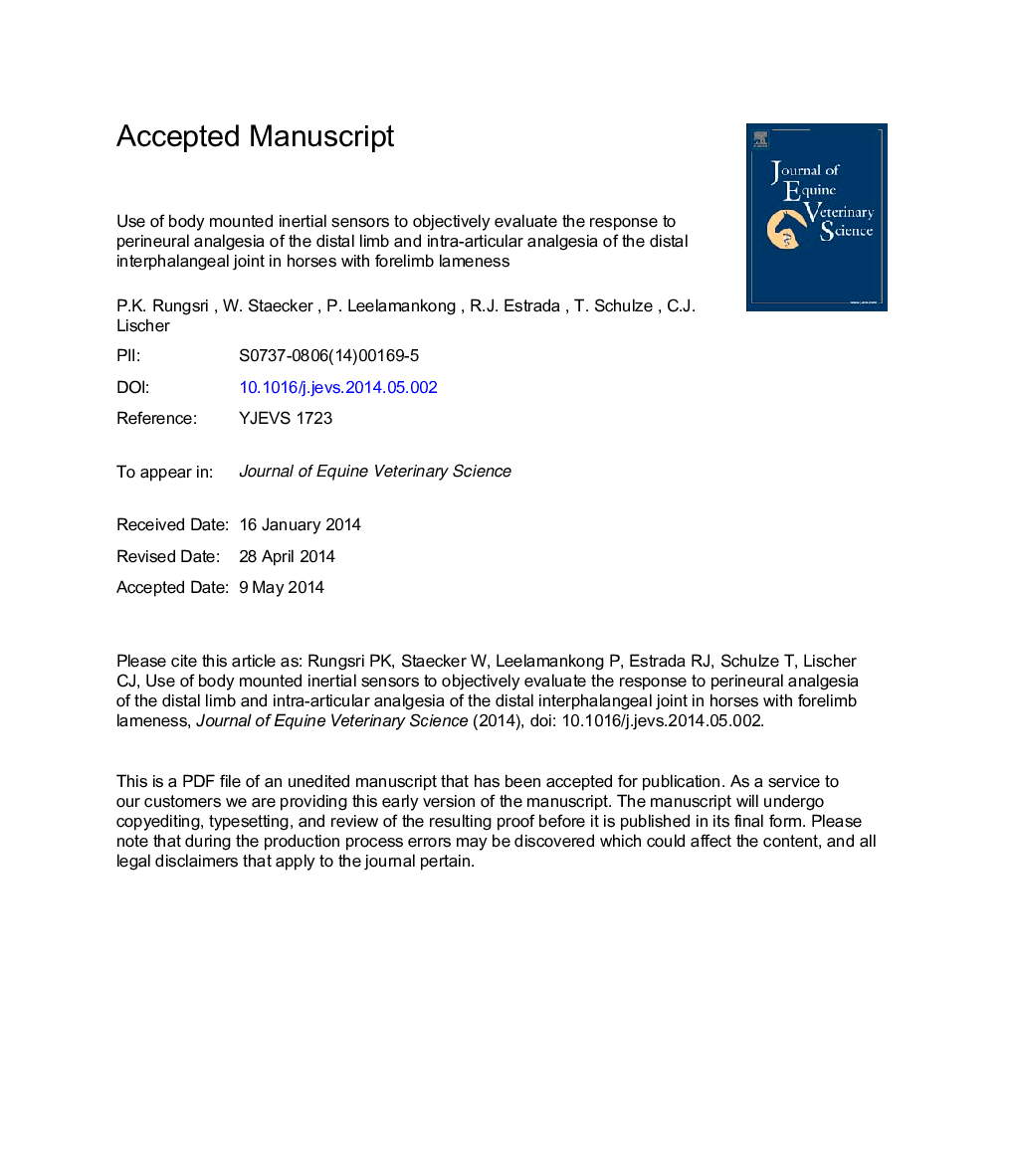| کد مقاله | کد نشریه | سال انتشار | مقاله انگلیسی | نسخه تمام متن |
|---|---|---|---|---|
| 10961375 | 1101555 | 2014 | 18 صفحه PDF | دانلود رایگان |
عنوان انگلیسی مقاله ISI
Use of Body-Mounted Inertial Sensors to Objectively Evaluate the Response to Perineural Analgesia of the Distal Limb and Intra-articular Analgesia of the Distal Interphalangeal Joint in Horses With Forelimb Lameness
ترجمه فارسی عنوان
استفاده از سنسورهای مجهز به بدن به منظور هدفمند ارزشیابی پاسخ به پریودرالژی ناحیه دندانه ای و ناحیه مفصلی داخل مفصلی ناحیه فک پایین در اسب ها با لنگی پیشانی
دانلود مقاله + سفارش ترجمه
دانلود مقاله ISI انگلیسی
رایگان برای ایرانیان
کلمات کلیدی
اسب، لنگ پا، بی اشتهایی تشخیصی سیستم سنسور درونی سیستم،
موضوعات مرتبط
علوم زیستی و بیوفناوری
علوم کشاورزی و بیولوژیک
علوم دامی و جانورشناسی
چکیده انگلیسی
Diagnostic analgesia of the distal interphalangeal (DIP) joint is theoretically helpful to localize the source of pain in the foot to the joint and/or navicular bursa. However, it has been suggested that potential diffusion of local anesthetic agent to nearby distal limb nerves may anesthetize other areas of the foot. The objective of this study was to compare the results of palmar digital (PD) and abaxial sesamoid (AS) nerve blocks to intra-articular anesthesia of the DIP joint in horses with distal forelimb lameness. Palmar digital nerve block (group 1) or PD and AS nerve blocks (group 2) were used to abolish digital pain in 22Â horses. The following day lameness was again evaluated in all horses before and 2, 5, and 10Â minutes after DIP joint anesthesia. All lameness evaluations were performed objectively with a body-mounted inertial sensor system (Lameness locator; Equinosis LLC, Columbia, MO). In group 1 horses, overall improvement in group lameness was the same after DIP joint block, but only six showed positive response after DIP joint analgesia, five after 2Â minutes, and one after 5Â minutes. In group 2 horses, overall improvement in lameness was less after DIP joint block, with seven showing a positive response after DIP joint analgesia, one after 2Â minutes, four after 5Â minutes, and two after 10Â minutes. Intra-articular analgesia of the DIP joint and perineural analgesia of the digit result in overlapping but unequal areas of analgesia. In addition, a time-dependent response was observed after DIP joint block with full effect requiring 5-10Â minutes.
ناشر
Database: Elsevier - ScienceDirect (ساینس دایرکت)
Journal: Journal of Equine Veterinary Science - Volume 34, Issue 8, August 2014, Pages 972-977
Journal: Journal of Equine Veterinary Science - Volume 34, Issue 8, August 2014, Pages 972-977
نویسندگان
Porrakote K. DVM, MS, Wolfgang DVM, Pitiporn DVM, Roberto J. DVM, Thorben DVM, Christoph J. Dipl. ECVS, Assoc. Dipl. ECVDI Large Animal,
